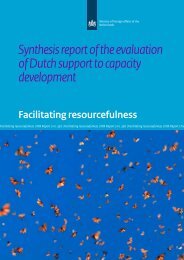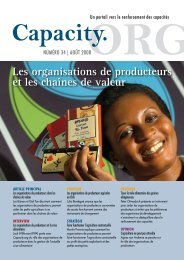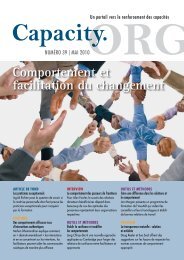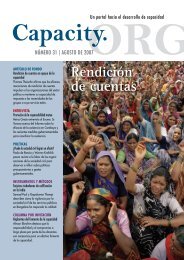FEATUREThe oilseed value chain – UgandaAn analysis of Uganda’s oilseed sub-sector in 2006revealed that there was great potential for growthin terms of productivity, income and employment.However, it was apparent that growth was stifled bypoor coordination, and lack of collaboration andinformation sharing between <strong>actor</strong>s. As a result, thesupply of inputs was inadequate, bulk purchasingwas a rarity, post-harvest handling facilities andtechnologies were inadequate, <strong>actor</strong>s lacked accessto finance, and sub-sector policies and regulationswere weak.When confronted with this analysis, the valuechain (VC) <strong>actor</strong>s decided to jointly tackle theconstraints in the value chain. One national andfour regional <strong>multi</strong>-stakeholder platforms (MSPs)were established comprising all relevant <strong>actor</strong>sin the VC including primary <strong>actor</strong>s (producers,input suppliers, researchers, processors, sectorassociations, warehouse owners and transporters);service providers (financial institutions, higherinstitutions of learning, business-developmentservices); and government and key donor agencies.SolutionsThe platforms have produced a number of solutions.The national platform contacted Uganda’s largestprocessor and seed importer, Mukwano Industries,who agreed to import enough hybrid seed for allthe farmers in the sub-sector. They also negotiated afunding guarantee scheme through the AgriculturalSector Programme Support, a project run by theDanish International Development AssistanceAgency.This enabled the agro-input dealers’ association,UNADA, to distribute Mukwano’s seed using itsown nationwide input distribution network. Theplatform used the funding scheme to negotiatean agricultural loan guarantee with StanbicCommercial Bank. This scheme offered a 50%donor guarantee to all oilseed farmers taking outloans to buy ploughing implements. Some 50,000oilseed producers benefitted from this scheme.This requires considerable knowledge andappreciation of the sectoral context on theone hand and advisory and facilitation skillson the other. Whenever there was a directtechnical contribution, stakeholders werealways assured that the external advisorwould not take control or determine theagenda.What the cases do not describe in detail isthat in improving relations one has to dealwith interests, power and conflict. Often<strong>actor</strong>s do not trust each other very muchand a blame game may be going on. But thecases do show a highly practical and resultsorientedapproach to facilitation in suchpotentially difficult settings. On closerscrutiny, we can see a range of elements:• Brokering new contacts• Brokering information and knowledge tounderstand context• Hosting, chairing or facilitating meetings,trips, visits, etc.As a result of the policy dialogue <strong>org</strong>anised bythe platform, the Ugandan government introduceda guarantee scheme through commercial banks tomake it easier for farmers to access financing. Later,they introduced a warehouse receipts system in theoilseed-producing areas closer to the farmers. Muchof the information – especially on prices, sectortrends and production systems – was generatedfrom work on the rural information system.ResultsThe impact in terms of productivity, income andemployment was impressive. In three years, thenumber of households engaged in oilseed farmingincreased from about 150,000 to 500,000. Now,70% of oilseed-producing households have accessto hybrid, high-quality seed; yields have increasedfrom 600 kg-per-acre to 1000 kg-per-acre; farmgate prices for raw materials have increased fromabout 400 USh/kg to 850 USh/kg; and the numberof processors has increased from four to 34.TrustAt the root of this success is the <strong>change</strong> inrelationships. Actors who previously did nottrust each other and worked independently, nowrecognise that they all belong to one system. Theyhave set up collaborative relationships and jointstrategies to develop the VC. They have developedthe ability to think beyond specific <strong>actor</strong> interestsand focus on systemic issues to develop jointpositions and solutions.Solutions posed at regional MSPs haveinfluenced national policy decisions, ratherthan policy decisions being pushed down fromthe top. This has contributed to a favourableenvironment for producers to strengthen their<strong>org</strong>anisations and speak with a strong collectivevoice at platform discussions where they can nowarticulate their challenges and negotiate betterterms and conditions. The <strong>multi</strong>-stakeholder processthus served as a basis for the empowerment ofproducers and improved the engagement of other<strong>actor</strong>s at the same time.• <strong>Facilitating</strong> negotiation and deal-makingbetween <strong>actor</strong>s• Participating in innovation between<strong>actor</strong>s, ‘cultivating’ their commitment• Giving individual advice or coaching to<strong>actor</strong>s to strengthen their roles/capacities• Mediating in conflicts or difficultsituations• <strong>Facilitating</strong> <strong>multi</strong>-stakeholder processes orplatforms that extend over time• Being an administrative agent forfinancial arrangements between <strong>actor</strong>s• Promoting issues or perspectives thatothers can not take onNote the significant shift from ‘expert’ rolesto ‘facilitation’ roles – facilitation that isvery results-oriented and requires adequatesector knowledge. Kenyan advisor, ThomasWere, one of the co-authors of this article,explains: ‘As a capacity developmentspecialist in the livestock sector, I used toprovide fairly standard training andworkshops for NGOs, farmers’ <strong>org</strong>anisationsand governments. Now we engage with the<strong>multi</strong>-<strong>actor</strong> chain as a whole and I need toknow more to be able to point my clients todynamics, opportunities and contacts. So Ineed to be very familiar with thehappenings in the sector. At the same time, Icannot prescribe what should be done, and Ihave to be more responsive and skilled infacilitation than I was before. The <strong>actor</strong>sdetermine what is interesting and feasibleand can usually do so much better thanexternal players.’What Were is describing is the role of atrusted broker who decreases the levels ofrisk for <strong>actor</strong>s to engage and who helpsthem to do things that they did not considerfeasible before. During a recent conversationabout these and other cases, an observationwas made that a trusted advisor or broker is‘like an intelligent friend’. Such friends areresponsive to your situation and needs. Theyhave a fresh view and help to understandthe situation from various angles. They arerespectful and understanding, straight andhonest. And they are independent and donot try to please you or serve particularinterests. With such quality of support, thatelusive substance, ‘trust’ starts to become aconcrete reality.Conclusions and perspectivesThis leads us to three types of conclusions:conceptual and methodological insights;clues about how to improve theeffectiveness of development support; andprofessional challenges.From a conceptual and methodologicalperspective the findings point to:• An evolution in CD thinking and practicethat moves away from training and<strong>org</strong>anisational development towardsfostering the effectiveness of <strong>multi</strong>-<strong>actor</strong>systems• The recognition that capacity is highlyrelational and that many forms ofeffective capacity grow in the interactivespaces between <strong>actor</strong>s• The notion of ‘action CD’ that focuses noton capacity inputs but on supporting the<strong>change</strong> process led and carried out bylocal <strong>actor</strong>s with capacity developmentsupport woven into the process• The importance of a ‘trusted broker’ inimproving <strong>multi</strong>-<strong>actor</strong> dynamics and therelated understanding of a range offacilitating elements that can help<strong>multi</strong>-<strong>actor</strong> systems to gain newdynamics and levels of performanceFrom a perspective of ‘aid effectiveness’, itis relevant to note that all the cases in thisarticle show that fundamental <strong>change</strong>s inthe way <strong>actor</strong>s related to each otherresulted in systems functioning better thanbefore. This was evidenced by higherlevels of production, income andemployment. These cases illustrate howeffective <strong>change</strong> is created by and betweenlocal <strong>actor</strong>s and not simply through policyimplementation.6 <strong>Capacity</strong>.<strong>org</strong> Issue 41 | December 2010
Alamy / Michael RunkelTraditional beehive, EthiopiaBoosting the honey trade – EthiopiaIn 2005, Ethiopian beekeepers were producingjust small quantities of high-quality table honey.Most of what they produced was of a standardquality and destined for sale locally to be used intej, the traditional Ethiopian honey wine. Five yearslater, 27,000 producers managed to increase theproduction of high-quality honey resulting in anincrease of average household income by US$150.Now, ten honey processors are providing 400tonnes of honey annually for the export market.How did this <strong>change</strong> happen? Although asimple story in itself, the reality is a complex oneof facilitating immediate opportunities, stimulatinginnovation, building on or unlocking existinginitiatives, using flexible funding and providingservices.The story started at the 29 th Apimondia tradefair in Dublin, Ireland, in 2005 when Haile Gi<strong>org</strong>isDemissie, the enterprising director of Beza Marhoney processors recognised that there was a hugeexport market for Ethiopian honey. But he alsorealised that bringing honey to the internationalmarket was not something he could do alone.The spark of an ideaBack in Addis Ababa, he presented his ideas to a<strong>multi</strong>-stakeholder workshop <strong>org</strong>anised by SNV. Abasic value-chain analysis was carried out and thespark of his idea ignited enough interest amongthe participants to form a coordination group (CG)headed by Demissie. Over time, the CG has beenjoined by processors, exporters, newly establishedproducer associations, apex <strong>org</strong>anisations,certification and auditing service providers,financial institutions, government ministries, andresearch and educational institutions.The CG looked at ways of entering the EUmarket and addressed the issues of how to qualifyfor export licences and how to orchestrate sufficientvolumes of honey to fulfil overseas orders. SNV’srole was to bring the stakeholders together.Consultants were hired to advise on issues whereSNV and value-chain <strong>actor</strong>s had no expertise. Forexample, SNV assisted in liaising with a laboratoryin Uganda to use their facilities, and the Ministryof Agriculture helped exporters to acquire EUaccreditation for Ethiopian honey.A business perspectiveThe next step was the formulation of a StrategicIntervention Plan. This focused on three main areas:establishing export contacts, boosting processingcapacity and qualifying for certification. As thisrequired increasing the production of specificgrades of honey, f<strong>org</strong>ing stronger business linksbetween processors and producers was vital. Theselinks helped both parties by assuring a consistentsupply of honey for the processors and reliablemarket outlets for the beekeepers.In order to create these new links, levels of trusthad to be increased and relational risks reduced.New technologies also needed to be taken onboard, the service delivery had to be improvedin almost every area, and new ways had to befound for accessing finance and other inputs. Forexample ‘transitional beehives’, developed by anentrepreneurial farmer and improved by Holeta BeeResearch Centre, were tested for appropriatenessand affordability for Ethiopian beekeepers,specifically women beekeepers, and scaled-up withthe help of processors.All this activity resulted in the establishment ofthe Ethiopian Apiculture Board as a public-privatepartnership incorporating the CG and steeringfurther sector development.Transfer of expertiseSNV’s role was to facilitate the <strong>change</strong> process,especially through establishing business links,supporting planning, smoothing access to grantsand investment capital, and moderating the CG. Byengaging an Ethiopian CD firm, SNV transferred valuechain facilitation skills to a local <strong>actor</strong>. In the course ofthis process, SNV’s role <strong>change</strong>d to ‘value chain coach’for business innovations and CD services, and forreplication to other sectors and programmes.This suggests that action CD should be atcentre stage when we are rethinking the roleof capacity development in policy andpractice. Such action CD is based on threekey principles: <strong>multi</strong>-<strong>actor</strong> engagement; thematching of financial support with localresources, dynamics and ingenuity; andsupport that is responsive and flexible to thelocal <strong>change</strong> process. These present clearchallenges for many sector programmes.There is convincing evidence that<strong>multi</strong>-<strong>actor</strong> approaches have something quiteimportant to offer. But it needs furtherexploration as a professional domain. Someimportant professional challenges are:• Deepening the understanding of the rangeand variation of <strong>multi</strong>-<strong>actor</strong> processes,spaces, platforms and mechanisms, andexploring their relevance for varioussituations and purposes• Looking at the practices and principlesthat help sustain productive <strong>multi</strong>-<strong>actor</strong>spaces and dynamics; and doing thiswithout over-institutionalising them ormaking them overly formal• Exploring innovative financing andsupport strategies for <strong>multi</strong>-<strong>actor</strong> system<strong>change</strong> (see also the interview with HettieWalters on page 9)• Expanding the professional repertoire offacilitating and brokering <strong>multi</strong>-<strong>actor</strong>dynamics• Fostering learning opportunities forprofessionals in advanced <strong>change</strong>facilitation, especially for in-country andinternational capacity builders.Overall our central conclusion is:effectiveness is created ‘on the shop floor’and spreads most effectively throughbottom-up and horizontal links rather thanbeing imposed from the top. <strong>Capacity</strong> cannotbe taught. Rather it evolves from helping<strong>actor</strong>s to deal jointly with real-lifechallenges. So working consciously, ordeliberately, with <strong>multi</strong>-<strong>actor</strong> systems is anessential evolution. The concept of action CDhelps to shift away from a supply-pushapproach to responsive support. Workingwith <strong>multi</strong>-<strong>actor</strong> systems not onlycomplements and incorporates earliertraining and <strong>org</strong>anisational developmentapproaches, it also has the potential toaddress development challenges moreeffectively and to create more self-sustainingforms of capacity.













